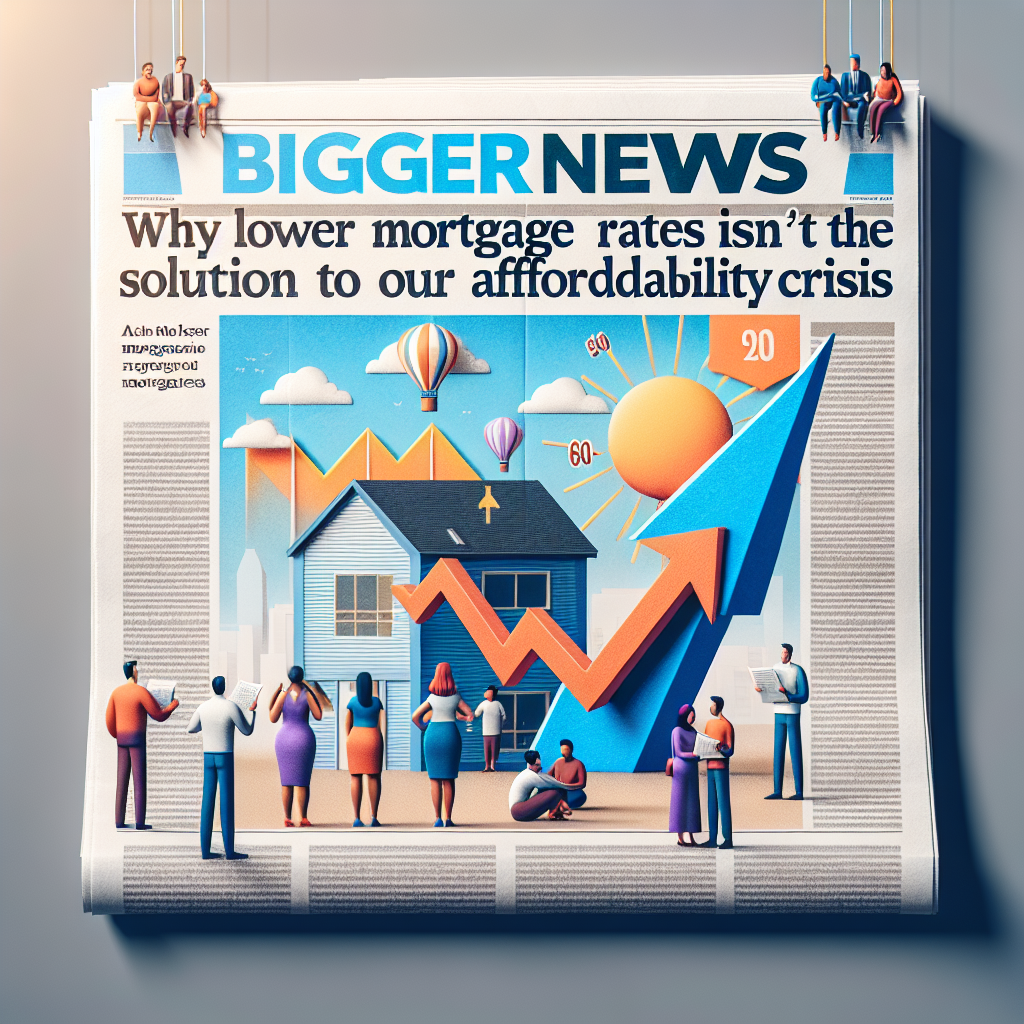-
Table of Contents
- BiggerNews: Why Low Mortgage Rates Aren’t the Solution to Our Affordability Crisis
- The Illusion of Affordability
- Case Study: The 2008 Financial Crisis
- The Supply Side of the Equation
- Income Inequality and Housing Affordability
- Market Dynamics and Investor Influence
- Policy Solutions Beyond Low Mortgage Rates
- 1. Increasing Housing Supply
- 2. Addressing Income Inequality
- 3. Regulating Investor Activity
- Conclusion
BiggerNews: Why Low Mortgage Rates Aren’t the Solution to Our Affordability Crisis

The housing affordability crisis has been a persistent issue in many parts of the world, particularly in urban areas. While low mortgage rates are often touted as a solution to this problem, they are not a panacea. In fact, they can sometimes exacerbate the issue. This article delves into why low mortgage rates alone are insufficient to solve the affordability crisis, exploring various factors such as housing supply, income inequality, and market dynamics.
The Illusion of Affordability
At first glance, low mortgage rates seem like a boon for prospective homebuyers. Lower interest rates reduce monthly mortgage payments, making homes appear more affordable. However, this perceived affordability is often an illusion. Here’s why:
- Increased Demand: Lower mortgage rates can lead to a surge in demand for homes, driving up prices. When more people can afford to borrow money, competition for available homes intensifies, leading to bidding wars and higher home prices.
- Speculative Buying: Investors and speculators are more likely to enter the market when borrowing costs are low, further driving up prices and reducing the availability of homes for regular buyers.
- Long-Term Costs: While monthly payments may be lower, the total cost of a home can be higher due to inflated prices. Buyers may end up paying more over the life of the loan, even with lower interest rates.
Case Study: The 2008 Financial Crisis
The 2008 financial crisis serves as a stark reminder of the dangers of relying solely on low mortgage rates to drive homeownership. Leading up to the crisis, mortgage rates were relatively low, and lending standards were lax. This led to a housing bubble, with home prices skyrocketing beyond sustainable levels. When the bubble burst, millions of homeowners found themselves underwater, owing more on their mortgages than their homes were worth.
This case study highlights the risks associated with low mortgage rates without adequate regulatory oversight and sustainable lending practices. It underscores the need for a more comprehensive approach to addressing housing affordability.
The Supply Side of the Equation
One of the most significant factors contributing to the affordability crisis is the lack of housing supply. Even with low mortgage rates, if there are not enough homes to meet demand, prices will continue to rise. Several factors contribute to the limited housing supply:
- Zoning Laws: Restrictive zoning laws and land-use regulations can limit the construction of new homes, particularly in desirable urban areas. These regulations often prioritize single-family homes over higher-density housing, reducing the overall supply of affordable units.
- Construction Costs: Rising construction costs, driven by labor shortages, material costs, and regulatory burdens, can make it difficult for developers to build affordable housing. These costs are often passed on to buyers, further exacerbating the affordability crisis.
- NIMBYism: “Not In My Backyard” (NIMBY) attitudes can hinder the development of new housing projects. Local opposition to new construction, particularly affordable or high-density housing, can delay or derail projects, limiting the supply of new homes.
Income Inequality and Housing Affordability
Another critical factor in the affordability crisis is income inequality. While low mortgage rates may make borrowing cheaper, they do not address the underlying issue of stagnant wages and rising living costs. For many households, the gap between income and housing costs continues to widen, making homeownership increasingly out of reach.
According to a report by the Joint Center for Housing Studies at Harvard University, nearly one-third of American households are cost-burdened, spending more than 30% of their income on housing. This issue is particularly acute for low-income households, who are more likely to be renters and face higher rent burdens.
Market Dynamics and Investor Influence
The role of investors in the housing market cannot be overlooked. In recent years, institutional investors have become significant players in the real estate market, purchasing large numbers of single-family homes and rental properties. This trend has several implications for housing affordability:
- Reduced Inventory: When investors buy up homes, they reduce the inventory available for regular buyers, driving up prices and making it harder for first-time buyers to enter the market.
- Rental Market Impact: Investors often convert purchased homes into rental properties, which can lead to higher rents. This dynamic can make it difficult for renters to save for a down payment and transition to homeownership.
- Market Stability: The presence of large institutional investors can contribute to market volatility. These investors may be more likely to buy and sell properties based on market conditions, leading to price fluctuations that can destabilize local housing markets.
Policy Solutions Beyond Low Mortgage Rates
Addressing the housing affordability crisis requires a multifaceted approach that goes beyond low mortgage rates. Here are some policy solutions that can help tackle the root causes of the crisis:
1. Increasing Housing Supply
To address the supply-side constraints, policymakers can take several steps:
- Zoning Reform: Reforming zoning laws to allow for higher-density housing and mixed-use developments can increase the supply of affordable units. This includes measures such as upzoning, which allows for taller buildings and more units per lot.
- Streamlining Permitting: Simplifying and expediting the permitting process for new construction can reduce delays and lower costs for developers, encouraging the development of more housing.
- Incentives for Affordable Housing: Providing incentives such as tax credits, grants, and low-interest loans for developers who build affordable housing can help increase the supply of units for low- and moderate-income households.
2. Addressing Income Inequality
To tackle the income side of the affordability equation, policymakers can implement measures to boost wages and reduce living costs:
- Minimum Wage Increases: Raising the minimum wage can help lift incomes for low-wage workers, making it easier for them to afford housing.
- Income Support Programs: Expanding income support programs such as the Earned Income Tax Credit (EITC) and housing vouchers can provide financial assistance to low-income households, helping them cover housing costs.
- Affordable Childcare and Healthcare: Reducing the cost of essential services such as childcare and healthcare can free up more income for housing expenses.
3. Regulating Investor Activity
To mitigate the impact of investor activity on housing markets, policymakers can consider the following measures:
- Regulating Short-Term Rentals: Implementing regulations on short-term rental platforms such as Airbnb can help ensure that homes are available for long-term residents rather than being converted into vacation rentals.
- Taxing Speculative Purchases: Introducing taxes on speculative real estate purchases can discourage investors from buying up large numbers of properties and driving up prices.
- Supporting Community Land Trusts: Community land trusts (CLTs) are nonprofit organizations that acquire and hold land for the benefit of the community. Supporting CLTs can help ensure that land is used for affordable housing rather than speculative investment.
Conclusion
While low mortgage rates can provide temporary relief for some homebuyers, they are not a comprehensive solution to the housing affordability crisis. The root causes of the crisis—limited housing supply, income inequality, and investor influence—require targeted policy interventions. By addressing these underlying issues, policymakers can create a more sustainable and equitable housing market that benefits all residents.
In summary, solving the affordability crisis requires a multifaceted approach that goes beyond low mortgage rates. Increasing housing supply, addressing income inequality, and regulating investor activity are essential steps toward creating a more affordable and stable housing market. By taking these measures, we can work towards a future where everyone has access to safe, affordable housing.








